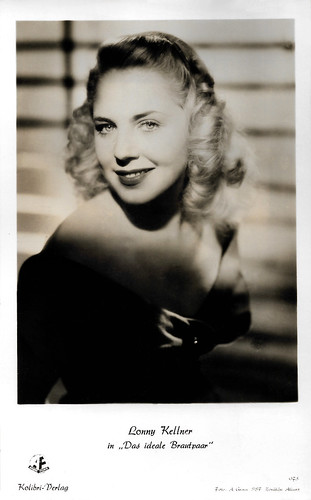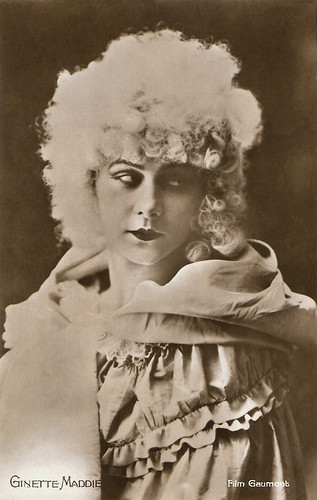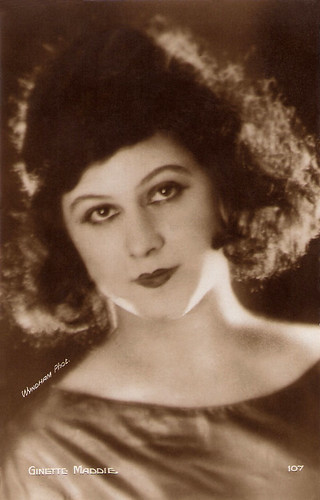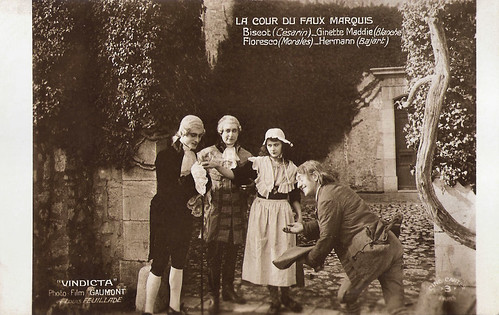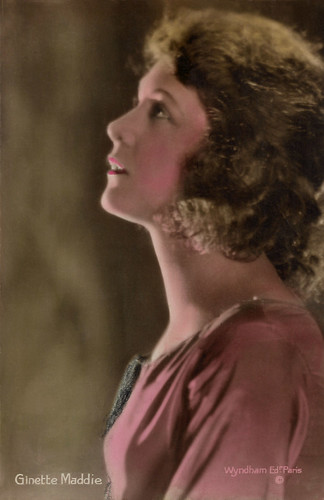Rudolf Dührkoop (1848-1918) was a Hamburg-based studio photographer, who from 1909 onward had a portrait studio in Berlin. When he died his talented daughter Minya Dührkoop (1873-1929) took over the studio. In the early 1930s, the company was called Gerstenberg-Dührkoop. Yet, in the postwar years, the name Dührkoop was used again for photos made for the new Ufa.

German postcard by Meissner & Buch, Leipzig. Photo: Rud. Dührkoop.
Sturdy and blond
Henny Porten (1890-1960) was one of Germany's most important and popular film actresses of silent cinema. She became the quintessence of German womanhood, ladylike yet kindhearted and a not a little petit bourgeois. She was also the producer of many of her films.

German postcard by Photochemie, Berlin, no. K. 1552. Photo: Rudolph Dührkoop, Berlin.
Actress and singer
Else Berna appeared in 13 silent German films between 1917 and 1924.

German postcard by Verlag Hermann Leiser, Berlin-Wilm., no. 5233. Photo: R. Dührkoop.
Paul Heidemann (1884-1968) was a German stage and screen actor, film director and film producer. He was famous for his comical parts.

German postcard by Ross Verlag, Berlin, no. 306/2, 1919-1924. Photo: Rudolf Dührkoop.
Viggo Larsen (1880-1957) was a Danish actor, director, scriptwriter and producer. He was one of the pioneers in film history. With Wanda Treumann he directed and produced many German films of the 1910s.
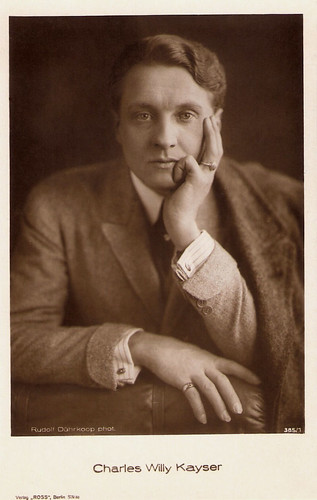
German postcard by Ross Verlag, Berlin, no. 385/1, 1919-1924. Photo: Rudolph Dührkoop.
German actor
Charles Willy Kayser (1881-1942) had a remarkable career in the silent cinema. However, today he is little known, while many of his films are considered lost now and there is little information about his work.
Rudolf Dührkoop
Hamburg-based photographer
Rudolf Dührkoop (1848-1918) made portrait photos and also took artistic photographs in the style of Pictorialism. Rudolf Johannes Dührkoop was born in 1848, the son of carpenter
Christian Friederich Dührkoop and
Johanna Friederica Emile. When the Franco-Prussian War broke out in 1870, Dührkoop volunteered to join Infantry Regiment No. 76 and was sent to Paris as an ordinary soldier after the capitulation. In 1872, he returned home, went into business and married
Maria Louise Caroline Matzen, with whom he had two daughters,
Hanna Maria Theresia, born in 1872, and J
ulie Wilhelmine, born in 1874.
Dührkoop first worked as a railway employee and then as a merchant. It was during this time that he became interested in photography. Dührkoop acquired the necessary knowledge over the years and familiarised himself with the necessary photographic processes and optics. In 1882, he published his first photograph in
Photographisches Wochenblatt, the magazine of the Photographischer Verein zu Berlin. At the end of 1882, Dührkoop applied to the Hamburg Chamber of Commerce for a photographer's licence, which was granted in January 1883.
In 1883, he opened a studio at Große Bäckerstraße 26 in Hamburg and effectively became a professional photographer without any training. Dührkoop began his professional career by making 'Cartes-de-Visite', a kind of business cards with small photographs. In addition, he mainly took portrait photos. He quickly gained success. Just six months after opening his studio, he moved to Hopfenmarkt. He was often asked to photograph prominent German personalities and joined the leading 'Deutschen Photographen-Verein' in 1886.
In 1888, Dührkoop moved into a studio in Ferdinandstraße and two years later, he opened an additional studio in Altona. Over the years, Dührkoop began to take reportage photographs. Outside his studio, he photographed, among other things, a celebration of the 25th anniversary of the 76th Regiment on the Heiligengeistfeld in 1891 and a festive scene on the Hopfenmarkt in 1892 on the occasion of a 50-year celebration to commemorate the outbreak of the Hamburg fire. He showed artistic aspirations and in 1898 he held his first exhibition, with a series of pictorialist portraits of his daughter
Minya. From then on, his fame rose all over Germany and later internationally. He opened another studio in Berlin, published in leading photographic magazines such as
Die Kunst in der Photographie and also wrote articles on portrait photography.
In 1904, he participated in the Louisiana Purchase Exposition in Saint Louis, where he came into contact with well-known pictorialist art photographers such as
Gertrude Käsebier. In 1905, he became the first German member of the prestigious English Royal Photographic Society and in 1906 of the pictorialist photography society Linked Ring. At the time, photographic societies organised exhibitions of photographic works by their members and invited photographers. At regular meetings, the members informed themselves about the latest developments. At such meetings, Dührkoop spoke, for example, about the experiences and successes of his trip to America in 1904. In addition to his artistic work,
Rudolf Dührkoop always remained active as a portrait photographer and captured a large number of well-known German personalities on film during his career.

German postcard by Ross Verlag, no. 3465/2, 1928-1929. Photo: Atelier Dührkoop, Berlin.
At the age of 18, German actor
Werner Fuetterer (1907-1991) was discovered to play the young lover in a series of silent films. For more than four decades he went on to work as a supporting actor in nearly 100 films.
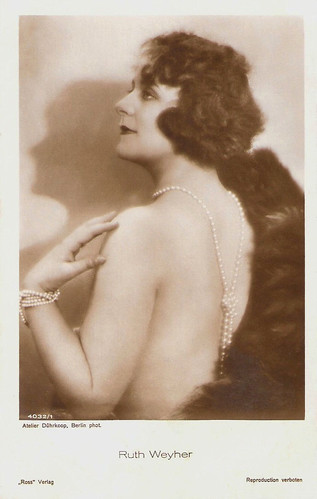
German postcard by Ross Verlag, no. 4032/1, 1929-1930. Photo: Atelier Dührkoop, Berlin.
Ruth Weyher (1901-1983) was a German actress of the silent cinema.

German postcard by Ross Verlag, no. 4237/1, 1929-1930. Photo: Atelier Dührkoop, Berlin.
Hans Stüwe (1901-1976) was a German singer and opera director. From 1926 on he was also a big film star in Germany. Four times he was the film partner of Ufa diva Zarah Leander.
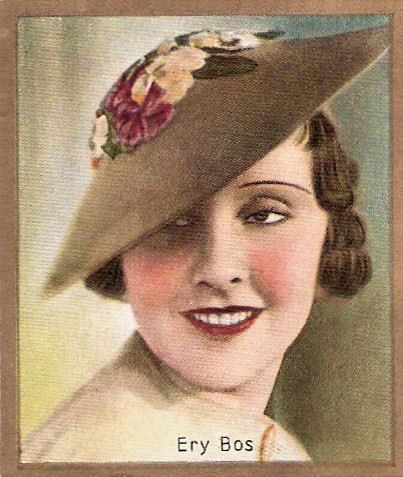
German collectors card by Salem Zigaretten in the series Bunte Filmbilder, no. 269 (in a series of 275). Photo: Dührkoop / Ross Verlag.
Dutch-German actress
Ery Bos (1910-2005) had a short but productive film career in the early German sound film. In only three years, from 1932 to 1934, she took part in a dozen films.
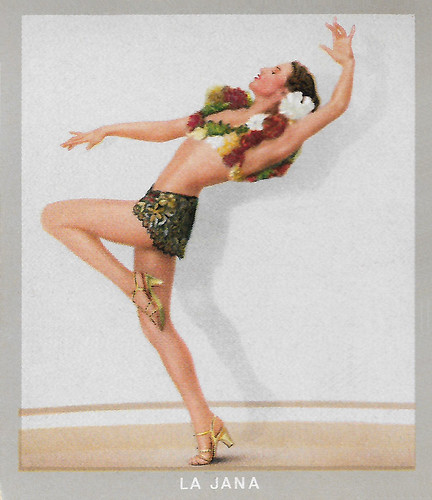
German cigarette card by Ross Verlag in the 'Künstler im Film' series for Zigarettenfabrik Monopol, Dresden, Serie 1, image 115 (of 200). Photo: Dührkoop.
Sexy German dancer and film actress
La Jana (1905-1940) was the most popular showgirl in Berlin in the 1930s. She appeared in 25 European films, often dancing in exotic costumes. In 1940, she suddenly died of pneumonia and pleurisy.
Much more than a simple assistant
In 1887,
Rudolf Dührkoop made his then 14-year-old daughter Julie Wilhelmine, known as Minya, his studio assistant.
Minya Dührkoop was trained as an independent employee and was to become much more than a simple assistant in the years to come. Father and daughter ran the business together. In 1894, Minya married the photographer
Luis Diéz Vazquez from Málaga. Nothing is known about any professional collaboration between the couple. When the marriage ended in divorce in 1901, Minya Diéz kept her married name.
Minya and Rudolf Dührkoop were able to assert themselves through the high artistic quality of their photographic work. In addition, the continuous cultivation and expansion of their artistic network was crucial to their success. In 1901, Minya and Rudolf Dührkoop embarked on their first trip to England. This was followed by trips to America in 1904/1905 to visit exhibitions and organise their own exhibitions, as well as to cultivate contacts with other photographers.
In September 1906, Minya Diéz-Dührkoop became a partner of "Rudolf Dührkoop." Rudolf left his daughter the newly rented Hamburg studio at Jungfernstieg 34 in the Heine-Haus and she managed the studio from this point onwards. Rudolf Dührkoop left Hamburg to open and run a "Werkstatt für künstlerische Camera-Bildnisse" and "Neuzeitliche Kamerabildnisse" in Berlin at Unter den Linden 10 in December 1906.
Minya Diéz-Dührkoop collected contemporary art. For example, she owned a painting by the painter
Alma del Banco. She moved in artistic circles in Hamburg and numerous writers and artists frequented her studio at Jungfernstieg 34. In 1910, she became a passive member of the Expressionist artists' association "Brücke" and cultivated contacts with writers such as
Richard Dehmel and his wife
Ida and visual artists such as
Max Pechstein,
Franz Radziwill and
Karl Schmidt-Rottluff
Encounters overseas also shaped her work. A highlight in Minya Diéz-Dührkoop's artistic and social life was the trip to the USA in 1911, which took place at the invitation of the Photographers Association of America. George Eastman had his portrait taken by Diéz-Dührkoop and there was also a professional exchange with the Swiss photographer Helmar Lerski in the USA. Minya and Rudolf Dührkoop's international fame grew steadily through various trips including trips to England in 1901 and 1908 to meet famous photographers such as
Emil Otto Hoppé and
Alvin Langdon Coburn. At that time, they were the only professional photographers from Germany to be accepted into the elite circle of the Brotherhood of the Linked Ring, otherwise only amateurs were admitted, who at the time had the higher artistic prestige.
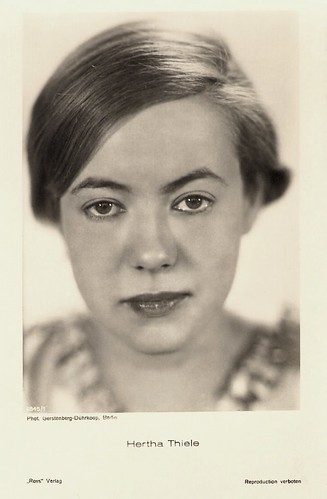
German postcard by Ross Verlag, no. 6845/1, 1931-1932. Photo: Gerstenberg-Dührkoop, Berlin.
For a brief period during the Weimar Republic,
Hertha Thiele (1908 -1984) appeared in several controversial stage plays and films. She is best known for playing a 14-year-old schoolgirl in love with her female teacher in the ground-breaking
Mädchen in Uniform/Girls in Uniform (1931). She received thousands of fan letters - mostly from women. Decades later, Thiele became a well-known film and television actress in East Germany.
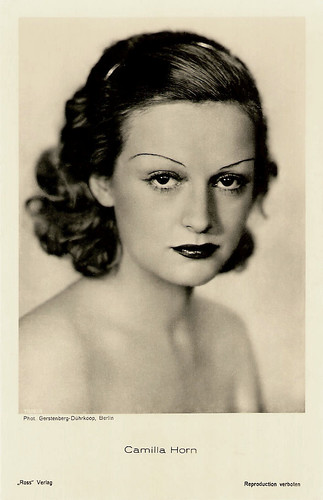
German postcard by Ross Verlag, no. 7916/2, 1932-1933. Photo: Gerstenberg-Dührkoop, Berlin.
Ethereally blonde
Camilla Horn (1903-1996) was a German dancer and film star. Her breakthrough role was Gretchen in the silent film classic
Faust (Friedrich Wilhelm Murnau, 1926). She also starred in some Hollywood films of the late 1920s and a few British and Italian productions.
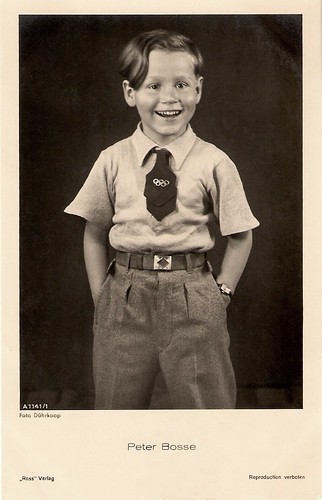
German Postcard by Ross Verlag, no. A 1276/1, 1937-1938. Photo: Dührkoop.
Actor, presenter and journalist
Peter Bosse (1931-2018) was a popular child star of the German cinema in the 1930s. The boy with his cheeky face made 28 films.

German postcard by Ross Verlag, no. A 3150/1, 1941-1944. Photo: Dührkoop, Berlin.
German actor and director
Fritz Kampers (1891-1950) was a solidly built Bavarian character actor. In films from 1913, he was much in demand during the 1920s and 1930s. Kampers was often cast as robust or comic military types, or laconic, but good-hearted rustics in mountaineering or 'Heimat' films. He appeared in more than 260 films.

German postcard by Ross-Verlag, no. A 3586/1, 1941-1944. Photo: Dührkoop.
Rolf Weih (1906–1969) was a German film actor, who played supporting parts in many comedies and musicals of the 1930s and 1940s. After the war, he appeared in numerous Heimat films in West Germany.
Stars depicted in their own homes
Rudolf Dührkoop celebrated his 60th birthday on 1 August 1908 and two months later the studio celebrated its 25th anniversary. Dührkoop was presented with a gold medal from Duke Carl Theodor in Bavaria and the Silver Crown Medal from the Saxon Photographers' Association. In 1918, Rudolf Dührkoop died in Hamburg, aged 69.
Minya Diez-Dührkoop continued the company after the death of her father. She made many sepia-tinted portrait photos of artists such as the painters
Max Liebermann,
Franz Radziwill,
Emil Nolde and
Max Pechstein and the Hamburg dancers
Lavinia Schulz (1896-1924) and
Walter Holdt (1899-1924). Dance poses of Schulz and Holdt in expressionist costumes they made themselves were photographed in the Dührkoop studio in variations from the front and from behind, with different backgrounds and different costumes. The domain of contemporary dance must have inspired Minya Diéz-Dührkoop photographically and must have been of particular concern to her, as there are further images in
Der künstlerische Tanz unserer Zeit (1928).
She also continued to depict the actors of silent German cinema like film diva
Henny Porten. The stars were often depicted in their own homes, without the scenery or props commonly used at the time. In one article, published in the journal
Deutsche Kunst und Dekoration, the Dührkoop studio was described as “radical” with a “determined striving towards the future”.
In 1926, Minya remarried. Her second husband was
Fritz Karl Gustav Schulz.
Minya Dührkoop died in 1929 in Hamburg.
Fritz Karl Gustav Schulz continued to run the studio after his wife's sudden death. In the early 1930s, the company was called Gerstenberg-Dührkoop. The studio continued to make portraits of German film actors
From 1935,
Antonio Machado, a long-time employee, was the owner of the "Dührkoop Werkstätten". In the postwar years, the name Dührkoop was used again for film star photos made for the new Ufa, but also for the Defa in East Germany. When the Dührkoop studio stopped to exist is unclear.
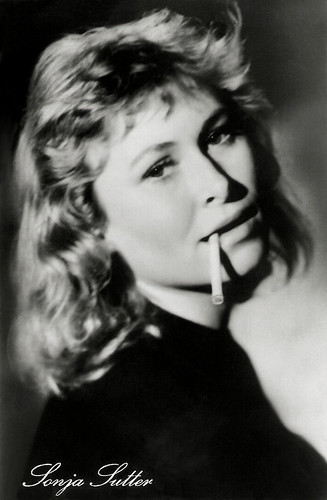
German postcard by VEB Progress Film-Vertrieb, no. 661, 1958. Photo: DEFA / Dührkoop. Publicity still for
Lissy (Konrad Wolf, 1957).
German film actress
Sonja Sutter (1931–2017) was one of the few actors who was allowed to appear in productions in both East and West Germany. She is remembered for DEFA films like
Lissy (1957), her role as Fraulein Rottenmeier in the German TV series
Heidi (1978) and for several roles in the TV series
Derrick (1983-1998).

German postcard by Ufa, Berlin-Tempelhof, no. FK 3058. Photo: Dührkoop / Ufa.
German actor and writer
Hardy Krüger (1928-2022) was a blond heartthrob in the 1950s. He acted in numerous European movies and also in classic American films.

West German postcard by Ufa/Film-Foto, Berlin-Tempelhof, no. FK 3327. Photo: Dührkoop / Ufa.
Renate Mannhardt (1920-2013) was a German supporting actress of the 1950s. She was known for such films as Peter Lorre's
Der Verlorene (1951),
Die große Schuld/The great debt (1953) and Roberto Rossellini's
Non credo più all'amore (La paura)/Fear (1954).
>

West German postcard by Ufa/Film-Foto, Berlin-Tempelhof, no. FK 3994. Photo: Dührkoop.
Heinz Drache (1923-2002) was the most in-vogue screen cop of post-war German cinema. He first established his reputation in the role of the charismatic Inspector Yates in Francis Durbridge's TV miniseries
Das Halstuch (1962) and in the same vein he apprehended villains in a series of Edgar Wallace Krimis such as
Der Zinker/The Squeaker (1963). He appeared in 42 films between 1953 and 2002.

German postcard by Ufa, Berlin-Tempelhof, no. FK 4230. Photo: Dührkoop / Ufa.
German film actress
Sabine Bethmann (1931) is best known for Fritz Langs’s
Der Tiger von Eschnapur (1959) and the sequel
Das Indische Grabmal (1959), together known as 'Fritz Lang's Indian Epic'.
Sources:
Viktoria Krieger (Liebermann Villa),
MKG Collection, Wikipedia (
Dutch and
German).

